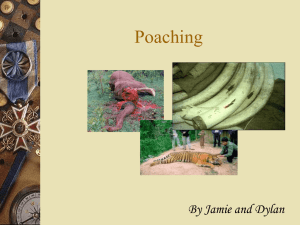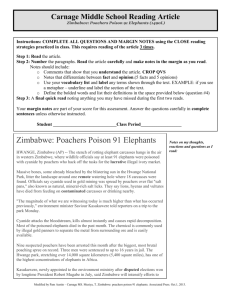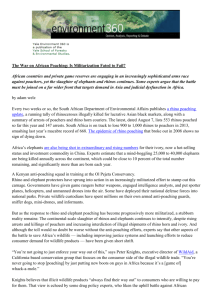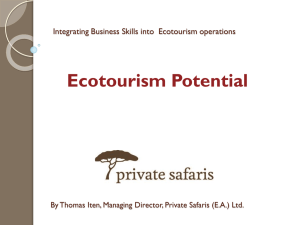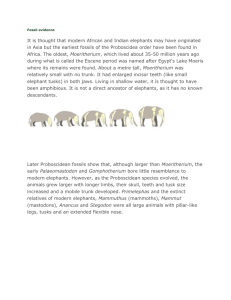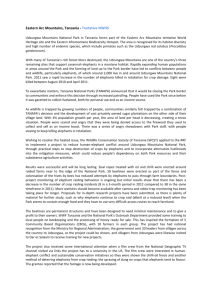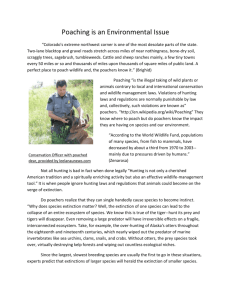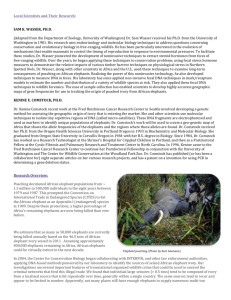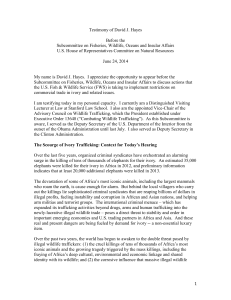Student Handout
advertisement
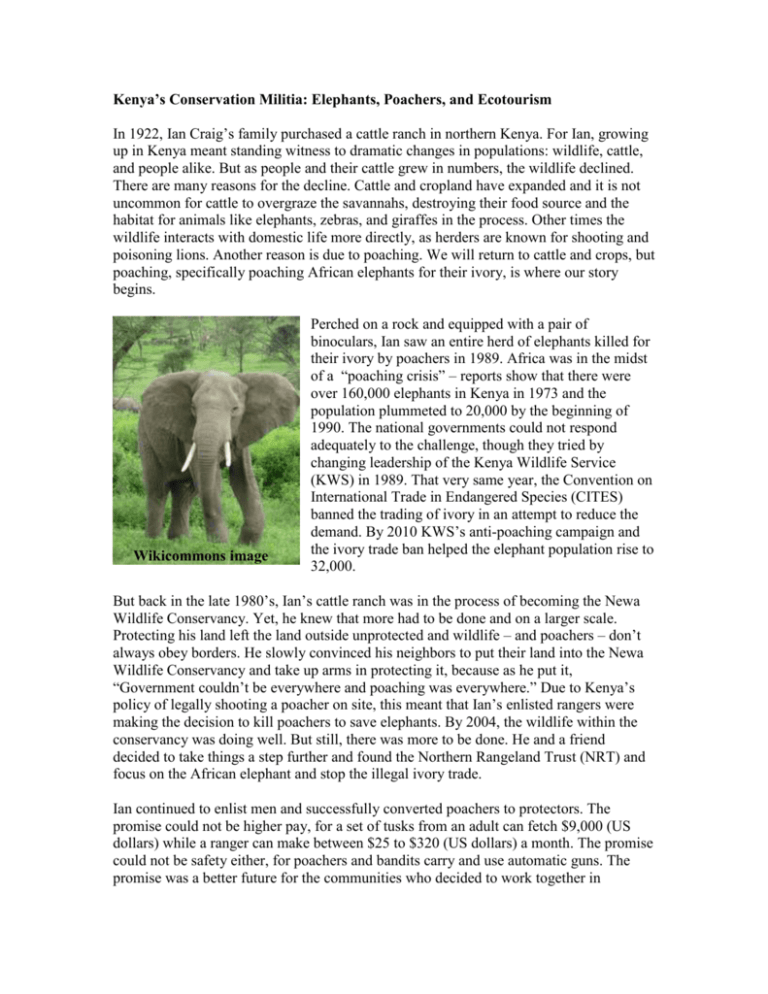
Kenya’s Conservation Militia: Elephants, Poachers, and Ecotourism In 1922, Ian Craig’s family purchased a cattle ranch in northern Kenya. For Ian, growing up in Kenya meant standing witness to dramatic changes in populations: wildlife, cattle, and people alike. But as people and their cattle grew in numbers, the wildlife declined. There are many reasons for the decline. Cattle and cropland have expanded and it is not uncommon for cattle to overgraze the savannahs, destroying their food source and the habitat for animals like elephants, zebras, and giraffes in the process. Other times the wildlife interacts with domestic life more directly, as herders are known for shooting and poisoning lions. Another reason is due to poaching. We will return to cattle and crops, but poaching, specifically poaching African elephants for their ivory, is where our story begins. Wikicommons image Perched on a rock and equipped with a pair of binoculars, Ian saw an entire herd of elephants killed for their ivory by poachers in 1989. Africa was in the midst of a “poaching crisis” – reports show that there were over 160,000 elephants in Kenya in 1973 and the population plummeted to 20,000 by the beginning of 1990. The national governments could not respond adequately to the challenge, though they tried by changing leadership of the Kenya Wildlife Service (KWS) in 1989. That very same year, the Convention on International Trade in Endangered Species (CITES) banned the trading of ivory in an attempt to reduce the demand. By 2010 KWS’s anti-poaching campaign and the ivory trade ban helped the elephant population rise to 32,000. But back in the late 1980’s, Ian’s cattle ranch was in the process of becoming the Newa Wildlife Conservancy. Yet, he knew that more had to be done and on a larger scale. Protecting his land left the land outside unprotected and wildlife – and poachers – don’t always obey borders. He slowly convinced his neighbors to put their land into the Newa Wildlife Conservancy and take up arms in protecting it, because as he put it, “Government couldn’t be everywhere and poaching was everywhere.” Due to Kenya’s policy of legally shooting a poacher on site, this meant that Ian’s enlisted rangers were making the decision to kill poachers to save elephants. By 2004, the wildlife within the conservancy was doing well. But still, there was more to be done. He and a friend decided to take things a step further and found the Northern Rangeland Trust (NRT) and focus on the African elephant and stop the illegal ivory trade. Ian continued to enlist men and successfully converted poachers to protectors. The promise could not be higher pay, for a set of tusks from an adult can fetch $9,000 (US dollars) while a ranger can make between $25 to $320 (US dollars) a month. The promise could not be safety either, for poachers and bandits carry and use automatic guns. The promise was a better future for the communities who decided to work together in protecting wildlife and creating an ecotourism economy around them. Several conservancies built ecotourism lodges and campsites in the 1990’s started to see things from Ian’s perspective. Now more and more conservancies are forming, building ecotourism accommodations, and providing more stable employment in ecotourism work for the community. NRT now works with 26 communities who manage over 25,000 square kilometers (15,534 square miles). Approximately 500 rangers are now employed and they monitor the elephants on foot, with cars, two airplanes, a helicopter, and remotely. Their weaponry is a blend of Ian’s purchased guns and the rest provided by the Kenyan police. Though they do not officially report the number of poachers they kill, they do monitor the African elephants (and other species) within the NRT territory and report on how the ecotourism is changing their communities. For example, NRT has built and helps operate 16 primary schools and 2 secondary schools in addition to a range of safe drinking water wells. All of this is taking place within a changing political climate. As mentioned above, the trading of ivory was made illegal in 1989. But the ban was temporarily lifted in 2007 to allow some nations to sell off their stockpiles. There is a consensus that this temporary lift, though well intentioned, reignited the market demand for ivory and therefore the drive to poach elephants. Additionally, poachers who are caught, prosecuted, and found guilty face a three year jail sentence. But this changed in 2014 as new legislation now gives a life sentence for poaching elephants and rhinos. In class discussion questions: 1) Describe the conflicting environmental ethics that a poacher who turns into a ranger goes through. 2) How do the conflicting environmental ethics fit into virtue ethics versus deontological ethics versus consequentialism? Into anthropocentric versus nonanthropocentric environmental ethics? 3) Do you think the decision to kill poachers to save elephants is justified? Why? Homework assignment: Write down your argument for why you think the NRT’s rangers’ decision to kill poachers to save elephants is justified or not that you held at the end of class. Then look up data for elephant population change over time and the impact of ecotourism. You must use at least two official elephant monitoring sources and two impacts of ecotourism sources. Write an annotated bibliography for your sources. Recommended resources are provided online.
